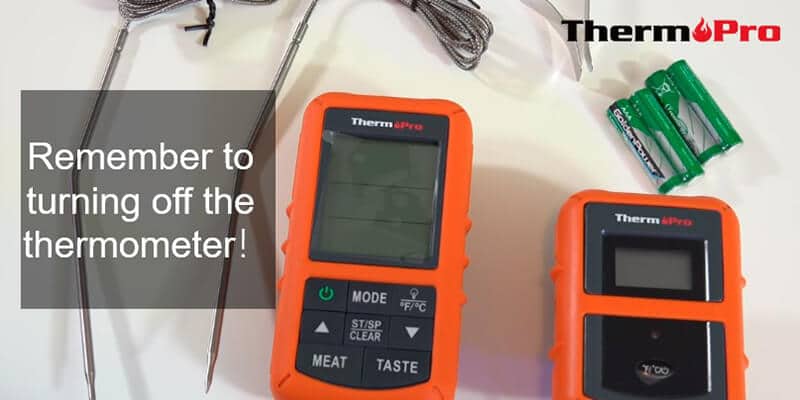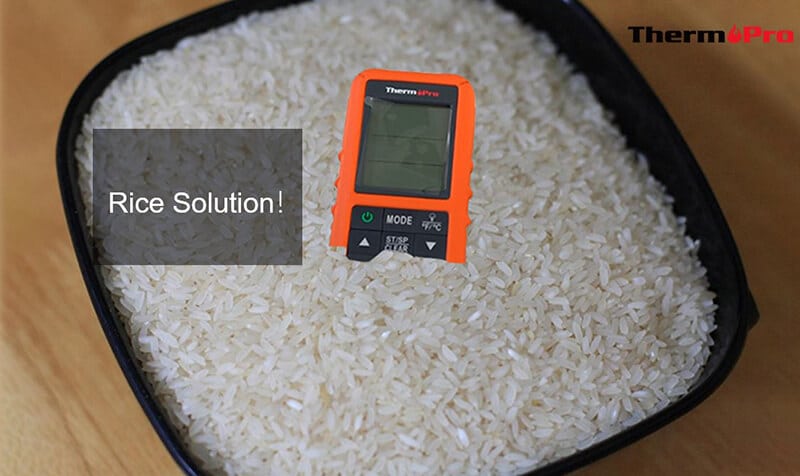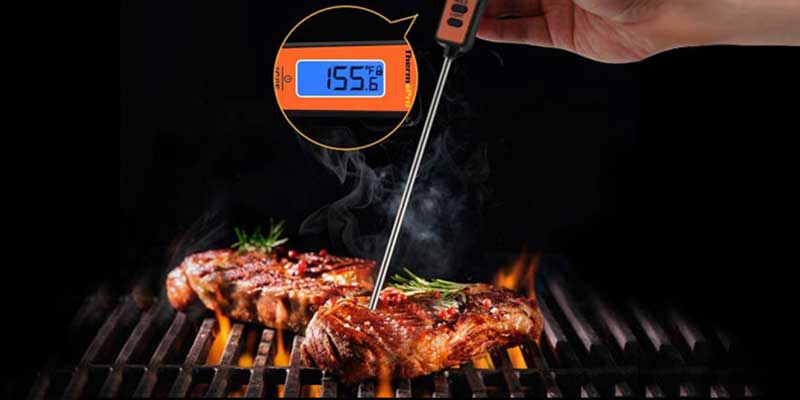The customer service team is always listening, taking notes, and quantifying complaints to ensure our products are continually improved. Due to selling directly to you, the customer, via Amazon, we can use product reviews to help us improve our existing products or help further development of new products.
Table of Contents
Well, now you’ve done it. You need to know how to get water out of a meat thermometer before your father-in-law discovers you borrowed his favorite thermometer. It’s a fairly advanced model, too, from Thermopro. Relax – you might be able to get the water out without suffering catastrophic damage, family hunger and hits to your culinary savvy.
However, the problem grows more complex if you need to get water out of a digital thermometer. Searching online will only provide contradictory information and recommendations that sometimes work and sometimes don’t.
Water Damage to Your Digital Thermometer
There are all types of digital thermometers, and water’s liquidity isn’t the only thing that can damage a digital thermometer as well as affect its reading. That’s because water contains various amounts of free-floating ions. Ions are electrically charged particles that can damage digital technology by creating short-circuits and making sensors malfunction.
Tips for Preventing a Digital Thermometer from Getting Wet When Cleaning
The best way to prevent water from getting into any thermometer is to clean it carefully. Some thermometers are fully submersible and dishwasher-safe, but you can prevent fogging and condensation by cleaning and sterilizing the instrument manually. Thermometers with small pieces and tight connections can be cleaned with Q-tips and rubbing alcohol. You should still wipe the thermometer’s parts with a bleach or disinfectant solution for the best cleaning results. Rinse and dry the unit carefully after cleaning and disinfecting.
When cleaning thermometers, some people get too aggressive or careless and allow water to seep into units that shouldn’t be submerged in water. For example, digital thermometers have a probe section and a controller unit. The controller just needs wiping with warm, soapy water or a spray cleaner because it doesn’t come into contact with food. The probe needs more rigorous cleaning and disinfecting to prevent cross-contamination of foods.
Tips to prevent getting your thermometer wet when cleaning it include:
- Wiping and disinfecting the probe after each use to prevent bacterial buildup
- Wiping the unit with a soft cloth and soapy water until clean
- Disinfecting the thermometer with disinfectant or a bleach-water solution using just a few drops of bleach in a small amount of water
- Rinsing carefully after disinfecting
- Handling the thermometer away from sinks or buckets of water to prevent it from falling into the water
- Storing your thermometer away from sharp kitchen tools that could pierce the unit
Easy Steps for Removing Condensation from Your Digital Meat Thermometer
If the water got into your thermometers, there are the steps for you to remove condensation from your digital meat thermometer.
- Turning off the thermometer.
- Place the probe or body – whichever part has condensation – in a casserole dish, and cover it. Bake in a preheated 250-degree oven for 35 to 40 minutes. (Note: If necessary, bake a little while longer. )
- Condensation inside a grill thermometer is fairly easy to dry if it’s an analog model, but removing water from digital grill thermometers is more difficult.
- Recalibration. After removing the water, you have to recalibrate the thermometer to see whether it’s still accurate. Follow the manufacturer’s instructions for calibrating the thermometer, and test it on something that’s non-critical – such as a dish that you know exactly how long it takes to cook or boiling water.

Ways to Remove Water or Condensation
Of course, there are also some other strategies can help to remove water or condensation from your digital thermometer include recommendations from online readers. I’m only including those that I think to stand a chance of returning your thermometer to operability:
- Air-drying
Air drying occasionally works. Try air-drying the thermometer in the sun and moving it regularly to different positions. - The Rice Solution
Plain white rice is one solution that often works with various types of thermometers. You place the thermometer in a covered container of rice. Rice absorbs water rapidly – even without cooking. Covered rice in a sealed environment will suck up any water or moisture available. You should start by leaving the thermometer in rice for a day, but you can extend the time up to a week. If nothing improves by then, this is not the solution. - Water In, Water Out
If water gets in, it can get out. The challenge is finding the right conditions to draw the water out or evaporate it. You can try heating the thermometer in a slow oven, drying it out in the sun or blasting it with warm air from a hairdryer. These are great ideas for how to get the moisture out of grill thermometers. - Shining a Light on the Problem
Some people report success by leaving the thermometer on top of an incandescent light overnight. Be careful about how you position the instrument, but the technique often works to dry the water gently.

These are not guaranteed solutions – they work in some cases and not in others because the thermometer may already be damaged by the ions in the water. If none of the approaches work, you’ll have to replace the thermometer. If your thermometer is under warranty, that’s a plus – you can probably get it replaced at no charge.
ThermoPro offers comprehensive warranty plans for one to three years, and the company will replace your thermometer if it becomes defective within the warranty period. You don’t have to mail your old thermometer back; the company will just deliver a new one. That’s the absolute easiest way to get rid of water in your thermometer – replace it with a new one for free.
How to Dry a Candy Thermometer
Figuring out how to get water out of a candy thermometer can present a double challenge. Candy thermometers take more of a beating than any other type of thermometer. Candy – when cooked to the hard-crack stage – can cover your probe or thermometer with brittle candy and become impossible to clean by simple methods. Here’s one way to deal with the twin problems of cleaning and drying:
- The thermometer might need to be boiled to remove stuck-on candy.
- After cleaning the thermometer, you can disassemble it as much as possible by removing the cap at the end.
- Stick the thermometer in a warm oven until dry.
- You can also try air-drying the assembly in the sun, using a hairdryer or sticking the thermometer in a sealed container of rice for a day or so.
Alternatively, you can try this method of how to get condensation out of a candy thermometer. The candy maker gives tips for keeping your thermometer free of moisture and stuck-on candy.
Conclusion
The best way to deal with water intrusion is to follow the above recommendations. The techniques don’t always work 100 percent of the time, but you can prevent water intrusion from happening again by avoiding risks – such as leaving the thermometer in water for an extended period of time. Buying a high-quality thermometer is also a good strategy. I recommend the ThermoPro Meat Thermometer and the company’s other types of waterproof thermometers to give you the best prospects of thermometer survival if water intrudes.









